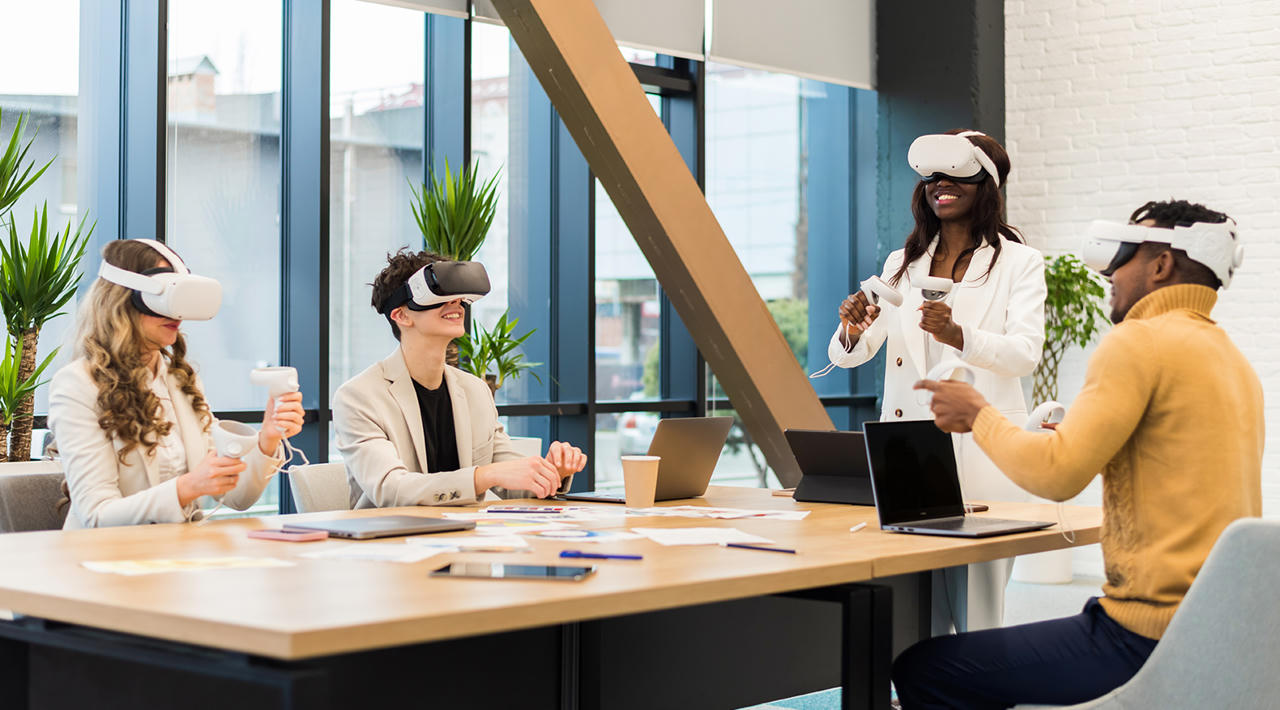How Does Virtual Reality Work: All the Basics You Need To Know

Virtual reality (VR) is no longer just a futuristic concept; it’s here, transforming how we play, learn, and even work. But despite its growing popularity, many people still wonder: how does virtual reality actually work?
To understand VR, you don’t need to be a tech expert. You need to know how different components come together to create the feeling of “being there” in a digital world. Let’s break down the essentials of virtual reality, from immersive experiences to the technology that makes it all possible.
What Is Virtual Reality?
Virtual reality is a computer-generated environment that simulates real or imagined worlds. When you wear a VR headset, you’re visually and audibly transported into that environment, where you can look around and interact almost as if you were physically present.
Unlike traditional screens or gaming setups, VR replaces your real-world surroundings entirely. The goal is to trick your brain into believing what you see is real, creating a powerful sense of presence.
Three main types of VR systems determine how deep this immersion goes: immersive, semi-immersive, and non-immersive.
The Three Levels of VR
1. Immersive VR
Immersive VR is the most advanced and realistic form of virtual reality. It uses high-end headsets, motion sensors, and sometimes even gloves or body suits to engage your senses fully.
When you turn your head, the environment moves with you. When you reach out your hand, you can grab or manipulate virtual objects. This type of VR is commonly used in gaming, military training, and medical simulations because it provides a true sense of “being inside” the virtual space.
Popular examples include the Meta Quest 3, HTC Vive, and PlayStation VR2, which all rely on advanced VR tracking systems to detect user movement in real-time.
2. Semi-Immersive VR
Semi-immersive VR blends elements of reality and simulation. You still interact with digital content, but you’re not completely isolated from the real world.
Think of flight simulators or large curved displays used in driving schools or pilot training. These setups use partial immersion to replicate specific experiences without requiring full VR headsets.
Semi-immersive systems are especially useful for education and professional training, where maintaining awareness of the physical environment is still important.
3. Non-Immersive VR
Non-immersive VR is the most common and accessible form; it’s what you experience when playing a 3D game on your computer or console.
You interact with a virtual world through a screen, mouse, or controller, but you’re always aware of your surroundings. While it doesn’t provide the same level of realism as immersive systems, non-immersive VR is ideal for everyday gaming, virtual tours, and architectural design.
The Key Components That Power VR
To make VR work, several core VR components work together behind the scenes. Each plays a crucial role in building that illusion of presence.
1. The VR Headset
The headset is the window to the virtual world. It contains two small screens, one for each eye, to create a stereoscopic 3D effect. However, modern headsets also include motion sensors, such as gyroscopes and accelerometers, that track your head’s position and rotation.
These sensors ensure the virtual world moves naturally as you look around. Combined with high refresh rates and low latency, they prevent motion sickness and maintain a smooth, believable experience.
2. VR Tracking Systems
Tracking is what makes VR interactive. Position tracking in VR determines where your head and body are in relation to the virtual environment.
There are two main tracking methods:
Outside-in tracking: Uses external cameras or sensors placed around the room to monitor your movements.
Inside-out tracking: Uses cameras built into the headset to track your motion without external equipment.
These VR tracking systems continuously update your position, ensuring that every move you make —whether stepping forward or turning around —is accurately reflected in the virtual space.
3. VR Motion Controllers
While the headset controls what you see, VR motion controllers handle how you interact. These handheld devices detect movement and orientation, letting you grab, point, throw, or draw within the virtual world.
Some systems also include haptic feedback, which uses vibrations or pressure to simulate touch. This tactile response adds another layer of realism, making actions like pulling a trigger or swinging a sword feel more lifelike.
In advanced setups, full-body tracking suits and gloves capture even more precise motion data, enhancing realism.
4. Audio Systems
Sound plays a major role in immersion. Spatial audio systems in VR headsets simulate sound direction and distance, so footsteps behind you actually sound like they’re coming from behind.
Moreover, high-quality, 3D audio completes the illusion, helping you react naturally to your environment and feel truly surrounded by it.
5. Computing Power
Finally, none of this would be possible without powerful processing. VR demands fast graphics rendering and minimal delay to feel convincing.
For instance, standalone headsets like the Meta Quest 3 have built-in processors, while others rely on PCs or gaming consoles for performance. Either way, smooth frame rates and quick response times are essential for an immersive experience.
How Virtual Reality Creates the Feeling of Presence
The magic of VR lies in a concept called presence: the sense that you’re physically part of the virtual world.
Presence is achieved by synchronizing what you see, hear, and feel with how your body moves. When visual cues, motion tracking, and sound align perfectly, your brain interprets the experience as real.
As a result, if tracking lags or visuals blur, that illusion breaks. That’s why companies continuously refine hardware and software to improve position tracking in VR, reduce latency, and enhance realism.
Applications of Virtual Reality beyond Gaming
Although VR first became popular through gaming, its impact reaches far beyond entertainment.
Healthcare: Surgeons use immersive VR to practice complex procedures safely.
Education: Students explore history, science, and geography in interactive, virtual environments.
Architecture and Design: Professionals visualize spaces before they’re built.
Work and Collaboration: Teams meet in shared VR offices, fostering remote collaboration that feels more human than video calls.
As the technology advances, we’re seeing VR become a tool for training, creativity, and even therapy.
The Future of VR: What’s Next?
The future of virtual reality is bright. We’re already seeing lighter headsets, improved VR tracking systems, and better wireless connectivity. Soon, mixed reality (MR) and augmented reality (AR) will blend seamlessly with VR, allowing us to shift between physical and digital spaces effortlessly.
Moreover, developments in AI and haptic technology promise to make experiences even more natural. Imagine touching objects that feel real or interacting with intelligent virtual characters that respond like humans.
As costs drop and accessibility improves, VR will continue to expand across industries, from entertainment and education to healthcare and remote work.
Final Thoughts
All in all, understanding how virtual reality works helps us appreciate the complex yet fascinating technology behind it. From immersive VR headsets to VR motion controllers and tracking systems, every component plays a part in creating digital worlds that feel real.
VR is more than a trend; it’s a gateway to new ways of experiencing, learning, and connecting. So, whether you’re stepping into a fantasy game, attending a virtual class, or training for your dream job, virtual reality is redefining how we engage with technology and, ultimately, with each other.
Building immersive experiences that feel real starts with the right foundation. At hulhub, our team blends creative design with interactive 4D development to help you craft virtual environments that captivate and convert. Let’s bring your digital vision to life, one experience at a time.
